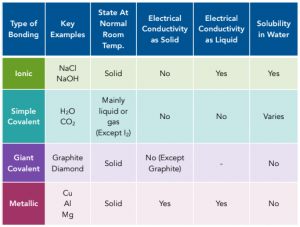Bonding - Predicting Structures (A-Level Chemistry)
Predicting Structures
Crystal Structures
A crystal structure is the ordered arrangement of many repeating units of atoms or ions into a three-dimensional regular lattice.
There are four main types of crystal structure that you need to know about:
1) Ionic – Consists of regularly arranged oppositely charged ions held together by strong electrostatic forces
2) Metallic – Consists of closely packed positive metal ions surrounded by a sea of delocalized electrons. The lattice is held together by the strong electrostatic forces of the oppositely charged ions and electrons.
3) Macromolecular (giant covalent) – Consists of many covalent atoms held together in a regular lattice by strong covalent forces
4) Molecular – Consists of simple molecules made up of a few atoms held together by strong covalent bonds. These individual molecules are held in a regular lattice by weak intermolecular forces of attraction such as hydrogen bonds or Van der Waals Forces.
The type of structure taken by a compound will greatly determine its physical properties and hence this can be used to predict the type of bonding present in a compound.
Predicting Structure
You should learn the properties of the following main types of bonding as you could be asked to predict the structure of a random substance based on its properties.

Practice Question: An unknown substance conducts electricity only when molten and dissolved in solution. It has a relatively high boiling point of 1245K. What is the type of structure that this substance has?
It can only conduct electricity when molten and dissolved in solution. This applies to all ionic compounds as when they are molten or dissolved, the ions are free to move around and carry charge/
It also has a high melting point. We know that ionic bonding involves a strong electrostatic attraction between oppositely charged ions. This means a large amount of energy is needed to overcome the forces.
The unknown substance must have an ionic structure.





Still got a question? Leave a comment
Leave a comment